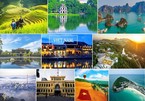 |
|
A view of Hoi An Ancient Town in the central Quang Nam Province. — Photo toidi.net
|
The number of foreign visitors to Viet Nam has been growing at a two-digit rate, but the return rate is low at somewhere between 10-40 per cent, experts said at the Viet Nam Travel & Tourism Summit 2019, that opened in Ha Noi on Monday.
According to statistics of the Viet Nam National Administration of Tourism under the Ministry of Culture, Sport and Tourism, international visitors’ spending in the country for a nine-day tour averaged only US$1,000, partly due to a lack of diverse products and services.
“In the recently released Travel & Tourism Competitiveness Index (TTCI) 2019 released by the World Economic Forum (WEF), Viet Nam jumped four places from the latest 2017 ranking, which shows the country has improved in competitiveness,” said Deputy Minister of Culture, Sports and Tourism Le Quang Tung.
However, Viet Nam still lags in the region considerably with regards to its tourist service and air transport infrastructure, weakness in environmental sustainability, the lack of product and location diversification, transport and services infrastructure and low-skilled labour force.
“Promotion activities have not showed actual effectiveness due to limited resources, loose operation mechanisms, a lack of overseas tourism promotion offices, the yet-operational tourism support fund and the overloaded airport infrastructure, which is unable to keep up with the growth of the number of tourists,” Tung said.
Viet Nam’s visa regime, which has been liberalised in recent years, still lags compared to more open visa policies of key regional competitors, such as Thailand, Indonesia and Malaysia, he said.
The forum was a national-scale event aiming to offer initiatives and solutions to overcome the limitations of Viet Nam’s tourism sector, he said.
Deputy Minister of Culture, Sports and Tourism Le Quang Tung addresses the Viet Nam Travel & Tourism Summit 2019 opened in Ha Noi on December 9. The forum was a national-scale event aiming to offer initiatives and solutions to overcome shortcomings and limitations of the Viet Nam’s tourism sector, contributing to improving its capacity and competitiveness. — Photo the courtesy of the Viet Nam Tourism Association
During the summit, four symposiums took place to discuss bottlenecks in Viet Nam’s tourism.
Revitalising national tourism promotion to inspire more foreigners to visit Viet Nam was the theme of the first symposium, during which participants contributed their ideas to improve the nation’s tourism messages and the operation of tourism offices abroad.
One of the proposals at the symposium was the early launch of a tourism development support fund, while other discussions dealt with how to address problems such as overcharging tourists, food safety and safety for visitors.
Another symposium looked at how to improve tourists’ experience in preparing and planning Viet Nam visits, considering the fact many visitors face difficulties in using Vietnamese online tourism services, such as real products not matching advertisements and a lack of direct consultancy.
Meanwhile, increasing tourism products, improving infrastructure, ensuring a safe environment, enhancing human resource quality and applying information technology were key issues discussed at the third symposium titled 'Improving tourists’ destination experience in Viet Nam'.
During this symposium, experts from an EU-funded project proposed piloting an index to rate the competitiveness of destinations in Viet Nam.
The fourth symposium focused on the development of aviation to serve tourism development.
Vu The Binh, Vice Chairman of Tourism Association, said tourism was an interdisciplinary economic sector, requiring the support of many industries and localities.
“There must be particular strategies to develop the services and products of destinations in each locality as well as preserving their traditional cultural value,” Binh told Viet Nam News.
“Many destinations in remote areas are difficult to access, thus localities should prioritise connecting roads, besides attaching environmental protection to tourism development, Binh said.
Tran Trong Kien, Chairman of the National Tourism Advisory Board (TAB), said Viet Nam's tourism industry had seen constant changes.
“In the past 10 years, most tourists booked their tours through travel agencies. Now, with the appearance of the internet, they have many more choices in their travel plans and journeys,” Kien said.
Kien suggested tourism enterprises start collecting information on customer data and use the information to provide services, helping enhance experiences for visitors.
The Government also needed to support firms to form a common database to promote Viet Nam's tourism on digital channels.
The Viet Nam Travel & Tourism Summit 2019 was held by the government’s Advisory Council for Administrative Procedure Reform, the Ministry of Culture, Sports and Tourism, the Viet Nam Tourism Advisory Board (TAB), the Viet Nam Tourism Association and VnExpress online newspaper. — VNS

Vietnam Travel & Tourism Summit 2019 opens in Hanoi
The Vietnam Travel & Tourism Summit 2019 opened in Hanoi on December 9 with four symposiums taking place in the morning to discuss bottlenecks of Vietnam’s tourism.

Vietnam still faces hurdles in tourism promotion
In 2018, the government approved to establish a public tourism development fund with an initial annual budget of US$4.3 million.
 Vietnam still lags in the region considerably with regards to its tourist service and air transport infrastructure.
Vietnam still lags in the region considerably with regards to its tourist service and air transport infrastructure.